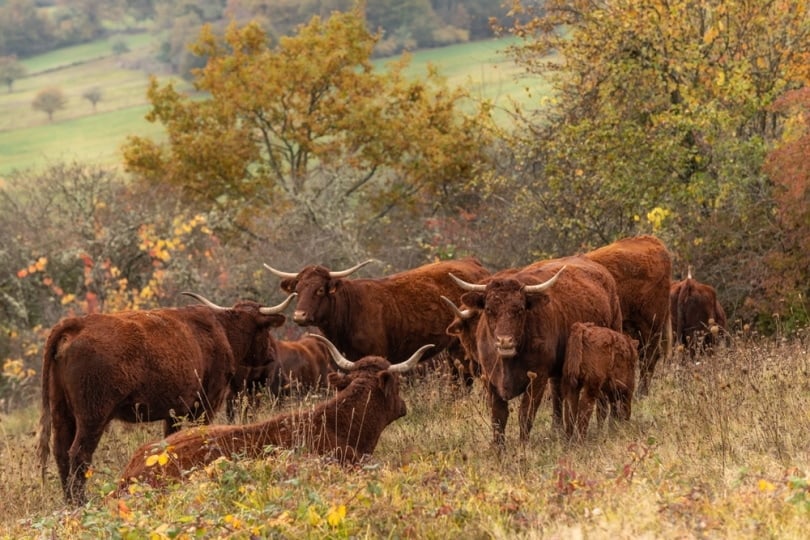If you were thinking about adding a few cattle to your small-scale farm, you’re bound to learn sooner or later about Salers cattle. Originating in France, these strong beauties make an excellent addition to rocky, hilly, or potentially treacherous terrain.
If you live in an unsuitable location for some other cattle breeds, you might want to look into this cattle group thoroughly. We think that these cows can make perfect additions to smaller operations under the right circumstances. However, we will say that these cows are mostly used for meat production rather than milk in western culture. Let’s dig a little deeper.

Quick Facts about Salers Cattle
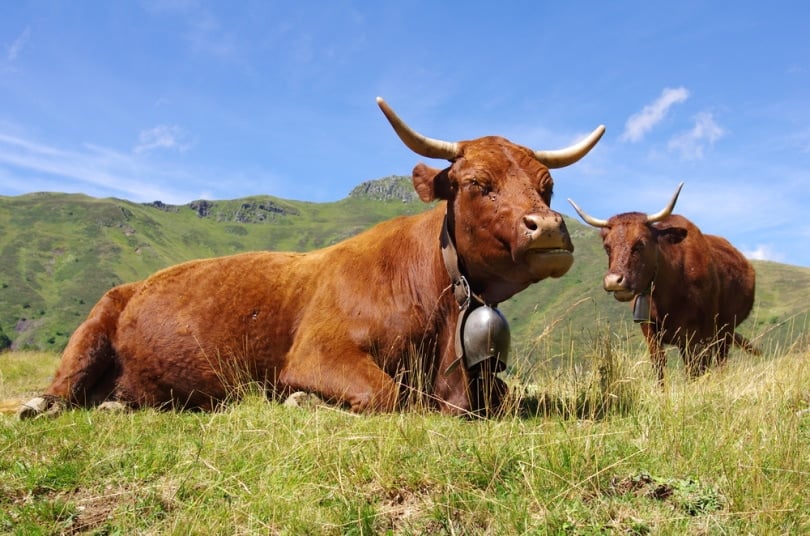
| Breed Name: | Salers |
| Place of Origin: | France |
| Uses: | Dual-purpose |
| Bull (Male) Size: | 2,500 to 3,300 pounds |
| Cow (Female) Size: | 1,500 to 1,600 pounds |
| Color: | Mahogany red |
| Lifespan: | 10+ years |
| Climate Tolerance: | Very tolerant to all climates |
| Care Level: | Easy |
| Production: | Meat, milk, calving |
| Temperament: | Docile |

Salers Cattle Origins
Salers cattle, pronounced ‘Sa-Lair’, is a French breed developed in desolate lands of Massif Central. The terrain here is notably rough, with rocky ground and minimal foliage. Because of the temperature variations and harsh environment, creators developed this cattle breed to withstand and thrive in these conditions.
The Salers breed is an ancient cattle type in the area, landing on cave paintings dating as far back as 10,000 years. While they were likely heavily related to the breed we know and love today, their ancestors were the hallmark of this region of France.
In this particular region, herders had cattle in the lower parts of the area. Once they had enough females, they would take them up to graze at the top of the mountains without males, as they would breed the females relentlessly.
Once females gave birth to calves, keepers kept the two together and used the bovine for milk. However, in today’s world, only 10% of Salers cattle are used for milk in their natural home of France.
These days, this breed is mainly used for meat production. They are especially attractive to keepers who live in otherwise troublesome or unpredictable regions, as they are highly adaptable and make fantastic foragers.
These sturdy guys and gals are some of the oldest and most genetically pure cattle breeds in the world.


Salers Cattle Characteristics
As we mentioned above, these cattle are primarily used for meat production in today’s world. However, characteristically speaking, these cows offer many upsides that some breeds do not. For instance, they have incredibly high success rates of calving.
Statistics show that the spread has a 10% influx of higher successful birth rates than many other cattle. They make amazing mothers, willing to have calves tag along anywhere. They get along well with other cattle, too. So, you can count on having a peaceful pasture.
As with any bull, male Salers cattle can be a bit of a handful. But surprisingly, these strong-bodied boys are gentler than many other breeds—and both genders are vastly intelligent and resourceful. However, bulls are very aggressive breeders and should be kept apart from cows once they reach sexual maturity.
Made for rugged terrain and harsh conditions, they will use their brains and survival-savvy instincts to withstand anything mother nature can throw their way.
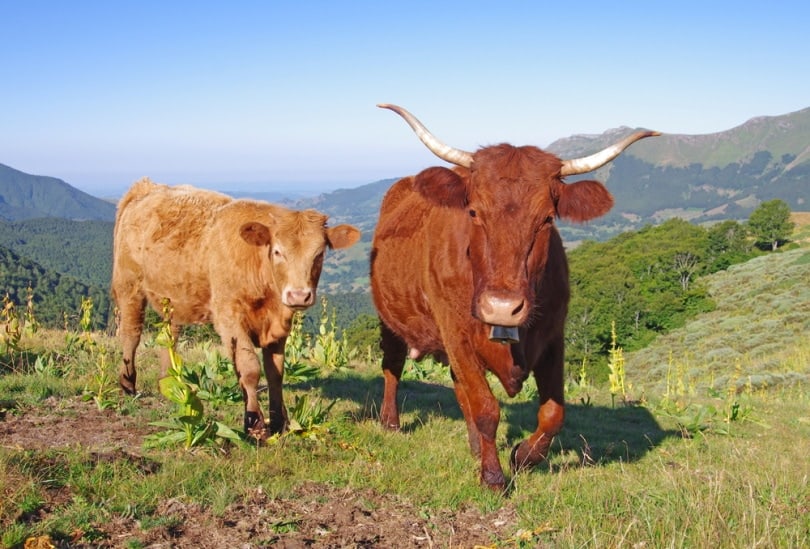
Uses
The Salers cow was bred to be a very hardy cow tolerant to all sorts of different environments. These cattle can withstand both hot and cold temperatures. While they were originally bred for working purposes, they also make lovely dual-purpose cattle, producing substantial milk and a heavy market weight.
Though they are still used for milk today, it is much more common in their native land—as western cultures use the breed primarily for meat.
Because of their powerhouse bodies, they make excellent workers, too. You can count on this cow for nearly any purpose, as they are healthy, hardy, and optimally useful as a helping hand.
Appearance & Varieties
Traditionally, Salers cattle are mahogany red to chestnut in color, and most are horned, even females. This became the gold standard for the breed, although breeders have since expanded slightly to give the Salers some variety in color and appearance.
Now, there are polled cows–plus, there has been a development in recent years of black color. So, while the breed grows, looks can change slightly with the progression. They have the advantage of flexible breeding programs nowadays that are not held to such a strict standard.
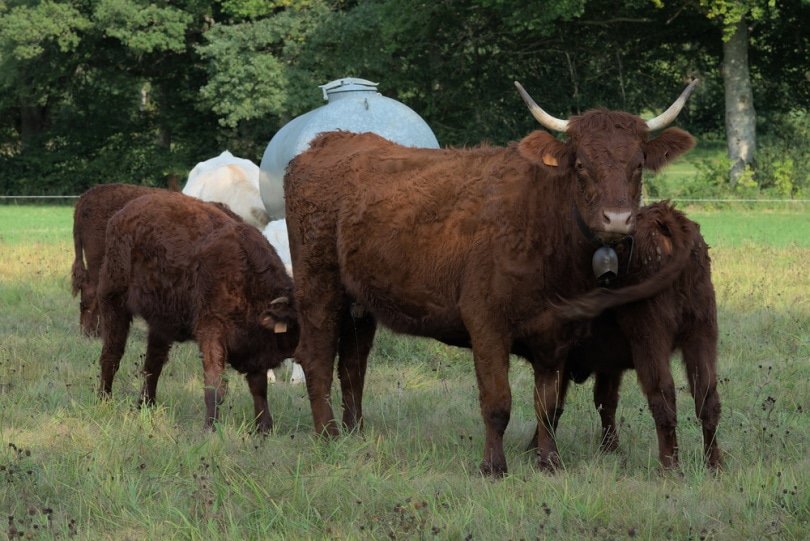
Population/Distribution/Habitat
The majority of these cattle are in their native home of France, with numbers exceeding 300,000. They are also exported to various countries worldwide, branching out into four continents globally.
With associations across these areas, you can research provided information in your region to see how you can purchase this specific cattle breed.
Like all cattle, this breed does best with plenty of acres to graze, requiring minimal shelter, but shelter, nonetheless. It would help if you always had a barn, building, or suitable shelter to keep them safe from the elements as needed.
They should also have access to fresh water at all times. In addition to grazing and feeding on foliage in the field, they will require high-quality cattle feed to keep them healthy.
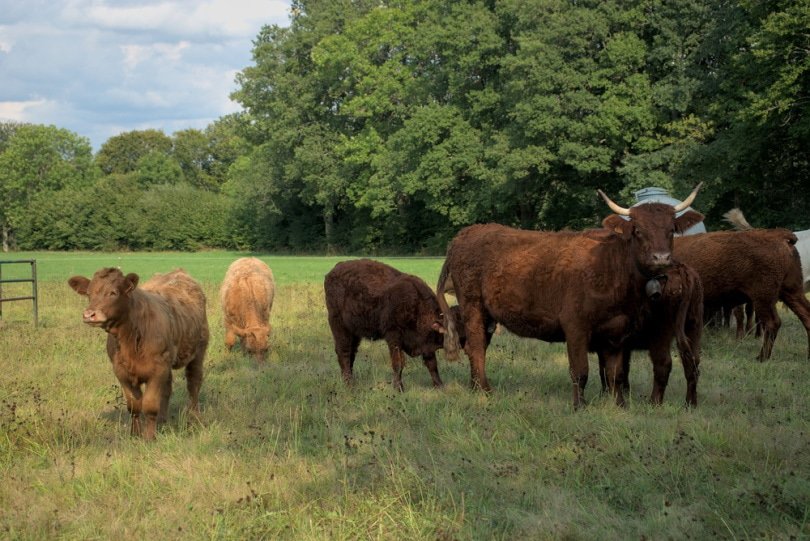

Are Salers Cattle Good for Small-Scale Farming?
Salers Cattle can make excellent additions to small-scale farms, permitting you to keep more than one. Cows are social creatures and require having at least another companion of like species. Because this particular breed is so widespread, you shouldn’t have any trouble locating a few for your setup.
These cattle make exquisite additions despite the temperature or terrain in your area. They are fantastic dual-purpose beauties that would pair well in most situations. Only you can use your judgment to decide if this breed will work for you.
Featured Image Credit: Images01, Shutterstock
